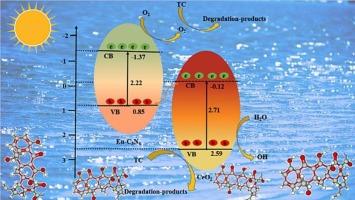p-n型CeO2/Eu-CN异质结体系的电子结构调制:有效促进四环素光催化降解
IF 6.9
2区 材料科学
Q2 CHEMISTRY, PHYSICAL
引用次数: 0
摘要
抗生素污染严重破坏了水环境的生态平衡。有效降解水中过量抗生素值得进一步探索。光催化抗生素降解不仅充分利用了太阳能,而且降解效率高,不产生副产物。本文采用固相法成功合成了一种新型的p-n异质结yCeO2/5Eu-CN光催化剂,该催化剂能在可见光下有效地降解抗生素四环素。首先,将稀土Eu离子掺杂到三聚氰胺煅烧制备的层状g-C3N4中,然后与CeO2结合,得到有效的复合光催化剂0.3CeO2/5Eu-CN。催化探索表明,它能有效地光降解四环素类抗生素,降解率为94.0 %,可循环使用3次,不损失光活性。控制实验表明,5Eu-CN光催化剂具有丰富的具有一定宽度的空穴态,通过n2p和Eu 3d的杂化,具有VBM的DOS分布,不仅提供了更多的活性位点,而且具有独特的极窄能带结构,表现出p型半导体特性。此外,5Eu-CN光催化剂与n型半导体CeO2复合,形成p-n异质结0.3CeO2/5Eu-CN。复合结构利用两种半导体的不同能带有效地促进了光生载流子的分离和迁移,显著抑制了电子-空穴对的络合作用,提高了光催化效率。理论计算还揭示了p-n异质结界面的电荷转移和相互作用。本工作实现了“材料设计结构-优化-机理阐明”整个链条的创新,为高性能p-n异质结光催化剂的设计提供了更清晰的思路和理论依据。本文章由计算机程序翻译,如有差异,请以英文原文为准。

Electronic structure modulation of p-n type CeO2/Eu-CN heterojunction system: efficient promotion of photocatalytic degradation of tetracycline
Antibiotic pollution seriously damages the ecological balance of the water environment. Efficient degradation of excessive antibiotics in water is worth further exploration. Photocatalytic antibiotic degradation not only makes full use of solar energy, but also exhibits high degradation efficiency and no by-product generation. In this paper, a novel yCeO2/5Eu-CN photocatalyst with a p-n heterojunction was successfully synthesized by solid-phase methodology, which can effectively photodegrade the antibiotic tetracycline under visible light. Firstly, rare earth Eu ions were doped into the layered g-C3N4 prepared by melamine calcination, and then combined with CeO2 to obtain the effective composite photocatalyst 0.3CeO2/5Eu-CN. Catalytic exploration indicates that it can effectively photodegrade tetracycline antibiotics with a degradation of 94.0 %, and is recycled three times without loss of photoactivity. Control experiments show 5Eu-CN photocatalyst possesses abundant hole states with a certain width and DOS distribution of VBM through the hybridization of N 2p and Eu 3d, which not only provides more active sites but also exhibits a unique very narrow energy band structure, showing p-type semiconductor characteristics. In addition, 5Eu-CN photocatalyst composites with the n-type semiconductor CeO2 to form the p-n heterojunction 0.3CeO2/5Eu-CN. The composite structure efficiently promoted the separation and migration of photogenerated carriers by utilizing the different energy bands of the two semiconductors, significantly suppressing electron-hole pair complexation and enhancing the photocatalytic efficiency. Theoretical calculation also reveals the charge transfer and interaction at the p-n heterojunction interface. This work has achieved innovation in the entire chain of “material design structure – optimization − mechanism elucidation”, providing clearer ideas and theoretical basis for the design of high-performance p-n heterojunction photocatalysts.
求助全文
通过发布文献求助,成功后即可免费获取论文全文。
去求助
来源期刊

Applied Surface Science
工程技术-材料科学:膜
CiteScore
12.50
自引率
7.50%
发文量
3393
审稿时长
67 days
期刊介绍:
Applied Surface Science covers topics contributing to a better understanding of surfaces, interfaces, nanostructures and their applications. The journal is concerned with scientific research on the atomic and molecular level of material properties determined with specific surface analytical techniques and/or computational methods, as well as the processing of such structures.
 求助内容:
求助内容: 应助结果提醒方式:
应助结果提醒方式:


